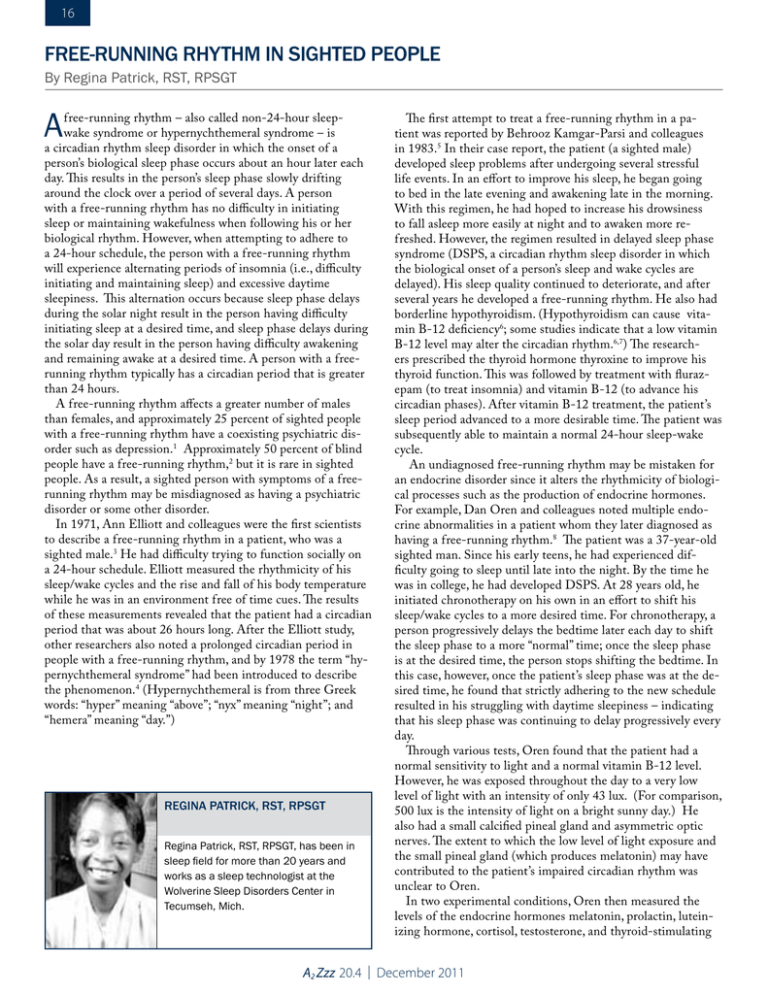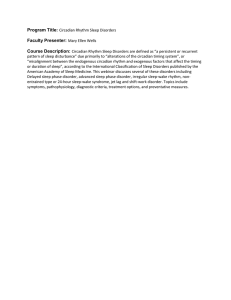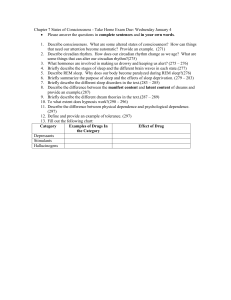FREE-RUNNING RHYTHM IN SIGHTED PEOPLE
advertisement

16 free-running rhythm in sighted people By Regina Patrick, RST, RPSGT A free-running rhythm – also called non-24-hour sleepwake syndrome or hypernychthemeral syndrome – is a circadian rhythm sleep disorder in which the onset of a person’s biological sleep phase occurs about an hour later each day. This results in the person’s sleep phase slowly drifting around the clock over a period of several days. A person with a free-running rhythm has no difficulty in initiating sleep or maintaining wakefulness when following his or her biological rhythm. However, when attempting to adhere to a 24-hour schedule, the person with a free-running rhythm will experience alternating periods of insomnia (i.e., difficulty initiating and maintaining sleep) and excessive daytime sleepiness. This alternation occurs because sleep phase delays during the solar night result in the person having difficulty initiating sleep at a desired time, and sleep phase delays during the solar day result in the person having difficulty awakening and remaining awake at a desired time. A person with a freerunning rhythm typically has a circadian period that is greater than 24 hours. A free-running rhythm affects a greater number of males than females, and approximately 25 percent of sighted people with a free-running rhythm have a coexisting psychiatric disorder such as depression.1 Approximately 50 percent of blind people have a free-running rhythm,2 but it is rare in sighted people. As a result, a sighted person with symptoms of a freerunning rhythm may be misdiagnosed as having a psychiatric disorder or some other disorder. In 1971, Ann Elliott and colleagues were the first scientists to describe a free-running rhythm in a patient, who was a sighted male.3 He had difficulty trying to function socially on a 24-hour schedule. Elliott measured the rhythmicity of his sleep/wake cycles and the rise and fall of his body temperature while he was in an environment free of time cues. The results of these measurements revealed that the patient had a circadian period that was about 26 hours long. After the Elliott study, other researchers also noted a prolonged circadian period in people with a free-running rhythm, and by 1978 the term “hypernychthemeral syndrome” had been introduced to describe the phenomenon.4 (Hypernychthemeral is from three Greek words: “hyper” meaning “above”; “nyx” meaning “night”; and “hemera” meaning “day.”) Regina Patrick, RST, RPSGT Regina Patrick, RST, RPSGT, has been in sleep field for more than 20 years and works as a sleep technologist at the Wolverine Sleep Disorders Center in Tecumseh, Mich. The first attempt to treat a free-running rhythm in a patient was reported by Behrooz Kamgar-Parsi and colleagues in 1983.5 In their case report, the patient (a sighted male) developed sleep problems after undergoing several stressful life events. In an effort to improve his sleep, he began going to bed in the late evening and awakening late in the morning. With this regimen, he had hoped to increase his drowsiness to fall asleep more easily at night and to awaken more refreshed. However, the regimen resulted in delayed sleep phase syndrome (DSPS, a circadian rhythm sleep disorder in which the biological onset of a person’s sleep and wake cycles are delayed). His sleep quality continued to deteriorate, and after several years he developed a free-running rhythm. He also had borderline hypothyroidism. (Hypothyroidism can cause vitamin B-12 deficiency6; some studies indicate that a low vitamin B-12 level may alter the circadian rhythm.6,7) The researchers prescribed the thyroid hormone thyroxine to improve his thyroid function. This was followed by treatment with flurazepam (to treat insomnia) and vitamin B-12 (to advance his circadian phases). After vitamin B-12 treatment, the patient’s sleep period advanced to a more desirable time. The patient was subsequently able to maintain a normal 24-hour sleep-wake cycle. An undiagnosed free-running rhythm may be mistaken for an endocrine disorder since it alters the rhythmicity of biological processes such as the production of endocrine hormones. For example, Dan Oren and colleagues noted multiple endocrine abnormalities in a patient whom they later diagnosed as having a free-running rhythm.8 The patient was a 37-year-old sighted man. Since his early teens, he had experienced difficulty going to sleep until late into the night. By the time he was in college, he had developed DSPS. At 28 years old, he initiated chronotherapy on his own in an effort to shift his sleep/wake cycles to a more desired time. For chronotherapy, a person progressively delays the bedtime later each day to shift the sleep phase to a more “normal” time; once the sleep phase is at the desired time, the person stops shifting the bedtime. In this case, however, once the patient’s sleep phase was at the desired time, he found that strictly adhering to the new schedule resulted in his struggling with daytime sleepiness – indicating that his sleep phase was continuing to delay progressively every day. Through various tests, Oren found that the patient had a normal sensitivity to light and a normal vitamin B-12 level. However, he was exposed throughout the day to a very low level of light with an intensity of only 43 lux. (For comparison, 500 lux is the intensity of light on a bright sunny day.) He also had a small calcified pineal gland and asymmetric optic nerves. The extent to which the low level of light exposure and the small pineal gland (which produces melatonin) may have contributed to the patient’s impaired circadian rhythm was unclear to Oren. In two experimental conditions, Oren then measured the levels of the endocrine hormones melatonin, prolactin, luteinizing hormone, cortisol, testosterone, and thyroid-stimulating A2 Zzz 20.4 | December 2011 17 Behaviorally, he was able to maintain a consistent sleep/wake schedule. However, alternating periods of severe insomnia and excessive daytime sleepiness indicated that his sleep/wake phases were not entrained (i.e., occurring in association with external cues such as light and darkness) and that his symptoms were the consequence of a free-running rhythm. How to best treat a free-running rhythm in a sighted person has not been definitively determined since most reports in the medical literature are case reports involving few people. For example, the finding that vitamin B-12 improves entrainment in some people with a free-running rhythm is based on two case reports,6,7 and no research has focused on its efficacy in entrainment.2 However, the results of various reports indicate that bright light therapy and the administration of melatonin effectively improve entrainment in some people with a free-running rhythm. Mark Brown and colleagues prescribed melatonin to advance the sleep phase in a 67-year-old sighted man who had a free-running rhythm that was coexistent with severe depression, anxiety, obsessive-compulsive disorder (OCD), and agoraphobia.11 The patient described having had problems for 22 years with “sleep cycling,” by which he meant that his sleep was progressively delayed by about one-half hour each day (i.e., free-running rhythm). For treatment, Brown prescribed melatonin (to advance the sleep phase), which the patient took one hour before going to bed. Each week, he took melatonin one-half hour earlier. Once the sleep phase was advanced to the desired time, he continued to take the dose of melatonin at the same time. He also underwent bright light therapy for one hour just after awakening to advance his wake phase. By maintaining this regimen, he was able to maintain a stable sleep/wake schedule. Angela McArthur and colleagues found that their patient was less sensitive than normal to the melatonin-suppressant effect of bright light.3 For example, at 2500 lux, his melatonin production was only reduced by 78 percent after two hours; in most people, melatonin production would be reduced by this much in one hour. Rather than using bright light therapy to shift the patient’s sleep/wake phases, McArthur prescribed melatonin. The patient took the medication daily, and by four weeks of treatment, his sleep/wake rhythms had stabilized. A physician may not think to assess a patient presenting with abnormal endocrine function or alternating periods of insomnia and excessive sleepiness for a free-running rhythm since it is rare in sighted people. The physician may instead treat the patient for another disorder such as depression, which may worsen the free-running rhythm. For example, certain serotonin reuptake inhibitor drugs used to treat depression may aggravate the free-running rhythm by decreasing a person’s response to light cues.3 An untreated free-running rhythm can be debilitating for a sufferer since alternating periods of insomnia and sleepiness hinder the person’s ability to effectively function socially, at work, or at school. Therefore, recognizing symptoms of a free-running rhythm in a sighted person may prevent the person from being misdiagnosed and suffering the consequences of improper treatment. A2 Zzz 20.4 | December 2011 Continued on Page 18 hormone (TSH). In the first condition, blood and urine samples were obtained to measure the level of melatonin when his biological “night” coincided with the solar night (i.e., when the patient was “in phase”). In the second experimental condition, blood samples were drawn when his biological “night” coincided with the solar day (i.e., when the patient was “out of phase”); his melatonin, thyroid-stimulating hormone (TSH), and testosterone levels were measured. The results showed that the patient had no detectable serum melatonin, although his urine had a lower-than-normal level of melatonin. When he was in phase, he lacked the normal surge of TSH production during sleep. When he was out of phase, he had an exaggerated TSH surge during sleep. Other endocrine hormones such as prolactin, luteinizing hormone (LH), and testosterone were at lower-than-normal levels. These abnormal findings indicated that the patient had an abnormal endocrine function. For treatment, the patient adhered to a strict sleep/wake schedule while undergoing bright light therapy (at 2500 lux) for two hours after awakening, and wearing dark goggles in the evening to minimize light exposure. After eight weeks of this regimen, the patient’s serum melatonin level returned to normal. Based on these findings, Oren suggests that a circadian rhythm sleep disorder such as a free-running rhythm should be part of a physician’s differential diagnosis in a person presenting with abnormal levels of endocrine hormones. In children, symptoms of a free-running rhythm may be mistaken for a learning disorder (since excessive sleepiness may cause problems with concentration) or mistaken for a psychological or psychiatric disorder (because of the alternating periods of insomnia and excessive sleepiness). In 2001, Dagan and Ayalon reported their experience with a 14-year-old male who had been diagnosed as having depression, schizotypal personality disorder, and learning disabilities.9 The researchers assessed the patient’s sleep with an overnight polysomnographic study because the patient had excessive sleepiness. The polysomnographic results were negative for any sleep disorders. The patient’s circadian rhythm was assessed by wrist actigraphy, which involves wearing a watch-like instrument that records the frequency of a person’s movements during wake and sleep. The results of wrist actigraphy showed he had a non-24-hour circadian period. Measurements of melatonin showed that his melatonin production was altered. They treated him with oral melatonin, which restored a normal sleep-wake schedule. A follow-up psychiatric evaluation found that he no longer suffered from any of his previous diagnoses. Delayed sleep phase syndrome may be a prodromal (i.e., forerunning) symptom in people who have a free-running rhythm since many people diagnosed with a free-running rhythm have struggled with DSPS for years before being diagnosed. Several researchers suspect that treating delayed sleep phase syndrome with chronotherapy later induces a free-running rhythm in some people. For example, it was after Oren’s patient had treated himself with chronotherapy that he noted that his sleep phase continued to delay about an hour later each day.8 In another report, Oren and his colleague Thomas Wehr described their experience with two patients who developed a free-running rhythm after undergoing chronotherapy.10 Angela McArthur and colleagues described a patient who had treated himself with chronotherapy for five years for DSPS.3 Continued from Page 17 18 REFERENCES 1. 2. 3. 4. Sack RL, Auckley D, Auger RR, et al. Circadian rhythm sleep disorders: part II, advanced sleep phase disorder, delayed sleep phase disorder, free-running disorder, and irregular sleep-wake rhythm. Sleep. 2007;30(11):14841501. Morgenthaler TI, Lee-Chiong T, Alessi C, et al. Practice parameters for the clinical evaluation and treatment of circadian rhythm sleep disorders. Sleep. 2007;30(11):1445-1459. McArthur AJ, Lewy AJ, Sack RL. Non-24-hour sleepwake syndrome in a sighted man: circadian rhythm studies and efficacy of melatonin treatment. Sleep. Sep 1996;19(7):544-553. Kokkoris CP, Weitzman ED, Pollak CP, et al. Long-term ambulatory temperature monitoring in a subject with a hypernychthemeral sleep--wake cycle disturbance. Sleep. Winter 1978;1(2):177-190. 5. Kamgar-Parsi B, Wehr TA, Gillin JC. Successful treatment of human non-24-hour sleep-wake syndrome. Sleep. 1983;6(3):257-264. 6. Ohta T, Ando K, Iwata T, et al. Treatment of persistent sleep-wake schedule disorders in adolescents with methylcobalamin (vitamin B12). Sleep. Oct 1991;14(5):414-418. 7. Okawa M, Mishima K, Nanami T, et al. Vitamin B12 treatment for sleep-wake rhythm disorders. Sleep. 1990 Feb;13(1):15-23. 8. Oren DA, Giesen HA, Wehr TA. Restoration of detectable melatonin after entrainment to a 24-hour schedule in a ‘free-running’ man. Psychoneuroendocrinology. 1997 Jan;22(1):39-52. 9. Dagan Y, Ayalon L. Case study: psychiatric misdiagnosis of non-24-hours sleep-wake schedule disorder resolved by melatonin. J Am Acad Child Adolesc Psychiatry. Dec 2005;44(12):1271-1275. 10. Oren DA, Wehr TA. Hypernyctohemeral syndrome after chronotherapy for delayed sleep phase syndrome. N Engl J Med 1992 Dec 10;327:1762. 11. Brown MA, Quan SF, Eichling PS. Circadian rhythm sleep disorder, free-running type in a sighted male with severe depression, anxiety, and agoraphobia. J Clin Sleep Med Feb 15 2011;7(1):93-94. Bachelor of Science (B.S.) in Neurodiagnostics and Sleep Science Our 2011 Sleep Testing and Respiratory Supplies catalog is filled with new and exciting products at fantastic prices! Call today to request our free catalog. 1415 Lawrence Drive Newbury Park, CA 91320 Toll Free: 1-877-735-MVAP (6827) www.mvapmed.com Earn your bachelor’s degree from the world’s first Neurodiagnostics and Sleep Science B.S. degree program from the University of North Carolina at Charlotte, with collaborative coursework offered by the University of North Carolina at Chapel Hill. The Neurodiagnostics and Sleep Science (NDSS) bachelor’s degree program is designed for a RPSGT or R. EEG T. like you—a busy professional, with job and family responsibilities. You can complete your bachelor’s degree online in as little as two years if you already have an associate’s degree. Coursework includes: • Advanced practice in neurodiagnostics and sleep science • Principles of education for leaders • Philosophy and application of scientific research • Philosophy and principles of laboratory management, health care administration, and finance For more information, visit www.med.unc.edu/ahs/ndss or contact Mary Ellen Wells at mwells@med.unc.edu or (919) 843-4673. A2 Zzz 20.4 | December 2011




